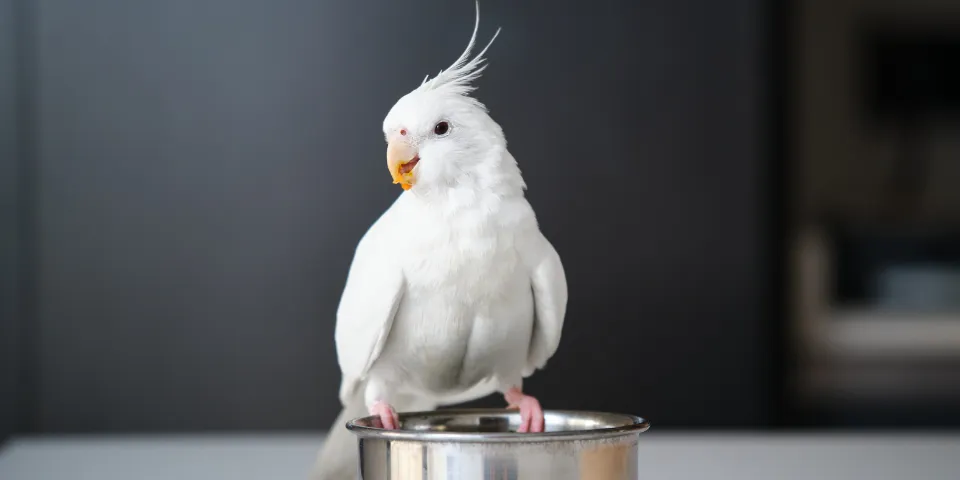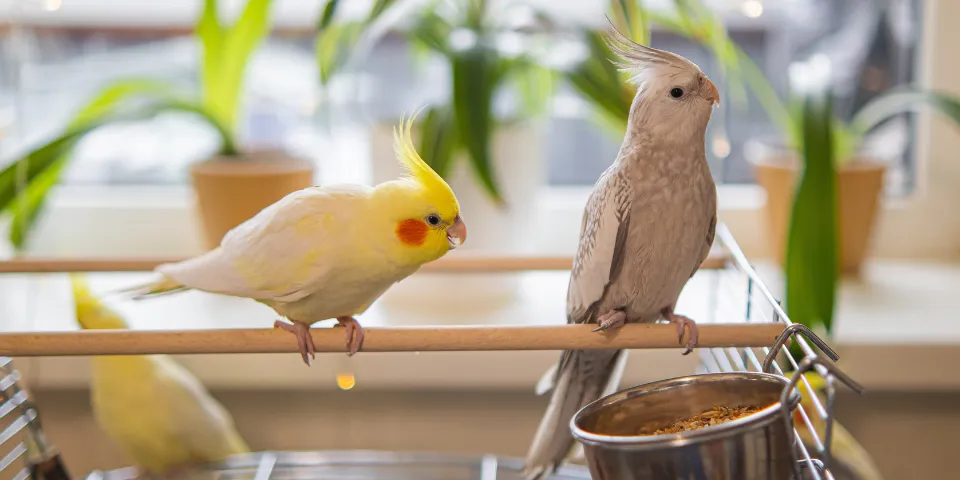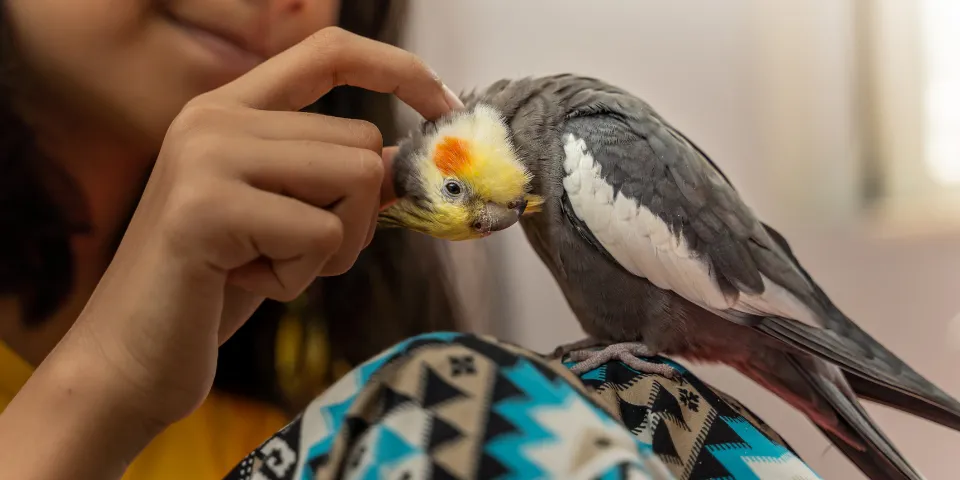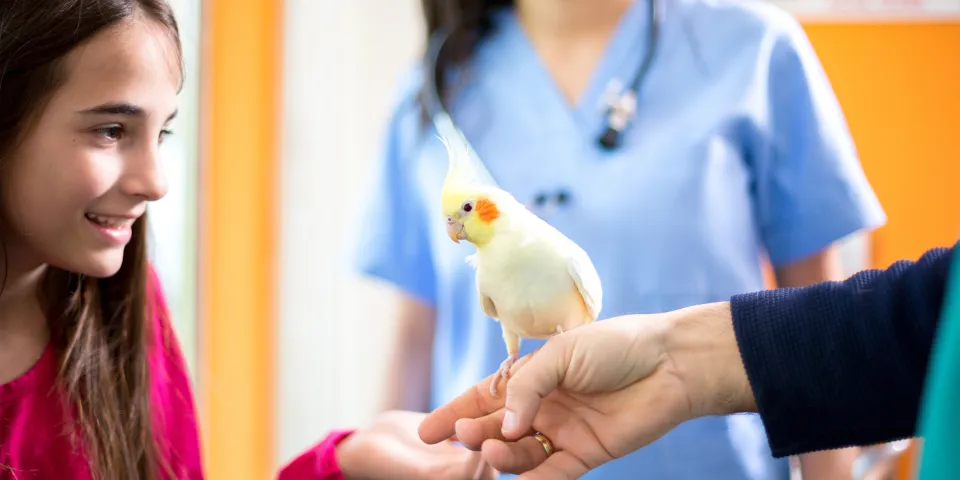Cockatiels are delightful, personality-packed birds that make wonderful companions for any household. These affectionate pets thrive with the right care, including a balanced diet, spacious housing, and plenty of interaction. Whether you’re a new owner or looking to improve your bird’s well-being, this comprehensive cockatiel care guide covers everything from essential nutrition to veterinary tips. Proper cockatiel care ensures your feathered friend lives a long, happy life full of chirps and play.
For more on cockatiel food diet, check out our detailed resources tailored for bird owners.
 Albino cockatiel eating from metal dish
Albino cockatiel eating from metal dish
Cockatiel Nutrition 101: Building a Balanced Diet
A nutritious diet is the cornerstone of cockatiel care. While seed mixes are popular, they often lack complete nutrition. Veterinary experts, including Dr. Veronica Pardini, DVM, CertAqVET, recommend prioritizing high-quality pellets as the daily staple, supplemented with limited seeds.
Seed Mixes vs. Pellets
Seeds are tasty but can lead to nutritional imbalances if overfed. Offer pellets formulated for cockatiels daily, plus about two teaspoons of a premium seed mix without sunflower seeds. ZuPreem’s Sensible Seed for large birds is a top choice, providing variety without excess fat. Ongoing avian nutrition research supports this 70-80% pellets to 20-30% seeds ratio for optimal health.
Fresh Fruits and Vegetables
Incorporate fresh produce to boost vitamins and keep meals exciting. Cockatiels love herbs like parsley, dill, and cilantro. Nutrient-dense veggies such as broccoli, sprouts, squash, green beans, and peppers are ideal. For treats, try blackberries, blueberries, raspberries, strawberries, figs, kiwi, persimmons, mango, or lychee—these add antioxidants and appeal to their sweet tooth. Wash everything thoroughly and introduce new items gradually to avoid digestive upset.
Explore further with our guide on cockatiel diet and nutrition.
Supplements and Hydration
Most cockatiels don’t need supplements with a varied diet, but cuttlebone supports calcium intake, especially for breeding females. Always provide fresh, clean water—bowls work best for monitoring intake, though bottles are an option. Change water daily to prevent bacterial growth.
 Two cockatiels on perch in cage
Two cockatiels on perch in cage
Cockatiel Housing: Creating a Comfortable Home
Cockatiels are active flyers despite their size, so housing plays a vital role in cockatiel care. A well-designed setup prevents boredom and supports physical health.
Cage Size and Perches
Minimum cage dimensions are 20-24 inches square, but larger is better—aim for at least 24x24x30 inches for flight space. Install multiple perches at varying heights and distances to encourage movement. Use natural branches, rope perches, and platforms of different diameters to mimic wild habitats, promoting foot health and preventing bumblefoot (pododermatitis).
Toys for Enrichment
Toys are essential for mental and physical stimulation. Rotate them every two weeks to maintain interest.
Foraging, Chew, and Interactive Toys
Hide treats in foraging toys to tap into natural instincts. Chew toys from safe woods or fibers keep beaks trimmed. Bells, mirrors, and swings provide sensory fun and exercise.
A dynamic environment reduces stress and feather-plucking behaviors common in understimulated birds.
 Woman petting cockatiel perched on her shoulder
Woman petting cockatiel perched on her shoulder
Bonding and Playtime: Strengthening Your Connection
Daily interaction builds trust in cockatiel care. Spend consistent, positive time with your bird to foster affection.
Clicker training uses treats and clicks to teach tricks, enhancing communication and cognition. Respect your bird’s pace—patience is key.
Fun Playtime Ideas
- Interactive Play: Dangle toys or roll balls for chasing.
- Obstacle Courses: Use perches and safe items for agility.
- Foraging Challenges: Hide food to stimulate hunting instincts.
- Music and Mimicry: Play soft tunes or whistle along—cockatiels love sounds.
- Quality Time: Talk, sing, or let them perch on you.
Watch body language: puffed feathers signal contentment, while fluffed-up posture or hiding may mean rest is needed.
Learn about food for cockatiel bird to enhance play with healthy treats.
 Young girl with pet cockatiel at veterinarian
Young girl with pet cockatiel at veterinarian
Veterinary Care: Prioritizing Prevention
Proactive health checks are crucial in cockatiel care. Find an avian vet before bringing your bird home.
Annual Exams and Emergency Signs
Schedule yearly wellness visits including exams, X-rays, and bloodwork to catch issues early. Birds hide illness, so act fast on symptoms like:
- Excessive sleeping
- Droppings changes (color, consistency)
- Appetite loss
- Labored breathing
- Regurgitation
Timely care from qualified vets like those certified in avian medicine can extend lifespan to 15-20 years.
Caring for cockatiels rewards with years of joy. Focus on balanced nutrition, enriching housing, bonding play, and regular vet visits for a thriving pet. Consult your avian veterinarian for personalized advice, and share your cockatiel stories in the comments below!
References:
- Dr. Veronica Pardini, DVM, CertAqVET (Published May 31, 2024)
- ZuPreem Avian Nutrition Guidelines
- Association of Avian Veterinarians (AAV) Recommendations
